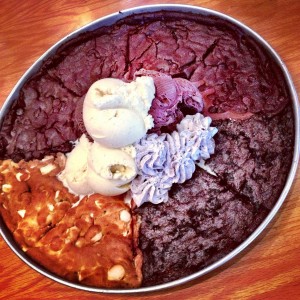
This is the Pazookie Party Platter from Bj’s Restaurant and Brewhouse that I took when we ordered it to celebrate my friend’s birthday. If you are like me, this image creates a favorable aesthetic reaction.
Objectives: There were three objectives that were put in place in hopes that we are able to complete or reach through our unit five blog posts as well as the responses we make to our group members post. The objectives for this unit are:
- Examine methods for evaluating qualities of art, such as product versus process, the difference between craft and fine art, must art be archival, and what is an aesthetic reaction.
- Explore the notion of food as an artform.
- Consider cultural differences in the production and consumption food.
Artifact(s):
1) ‘Food as Art Research’ blog post
2) ‘Art as Food’ blog post & comment in reply to group member’s comment
3) ‘Food as Art’ comment in reply to group member’s (Tyler) blog post
Reflection: After re-reading all my blog posts and and group responses, I would say that I was able to meet two of the four unit four objectives through the three artifacts that I provided links to above. I was able to find examples of me meeting these objectives in the responses that I wrote on my group member’s blog post as well as in my own blog post.
The first objective asked for several different things, which was challenging but I was able to accomplish it. The first part of the objective asked us to examine methods for evaluating the quality of art. I was able to show this in both my blog posts ‘Food as Art Research’ and ‘Art as Food’. In these posts, I mentioned some of the methods used to evaluate art that Tefler talked about the unit four reading. She referred to them as sense-experiences and it includes non-neutral, non-instrumental, intensity, and judgment. In my ‘Art as Food’ blog post I go on to describe each of these sense-experiences and how they maybe used to evaluate an artwork. This objective also required us to talk about the idea of product versus process as well as the difference between craft and fine art. I talked about these topics heavily in my ‘Food as Art Research’ blog post. I found an article that helped to support the ideas the Tefler introduced in the reading. Where the idea of fine art is the product of the process, also known as crafting. Somewhere along the line, the terms craft and fine art intertwine but are two separate ideas of their own. The last part of this objective is to examine what an aesthetic reaction is, this was shown in both of my blog posts; ‘Food as Art Research’ and ‘Art as Food’. In both of these posts I talked about what an aesthetic reaction is to me and went on to talk about Tefler’s definition of aesthetic reaction. Before this course, aesthetic reaction was an attitude or thought that was cause by an objects aesthetics but now I know that there’s so much more to what an aesthetic reaction is.
We were required to explore the notion of food as an art form for the second objective. Majority of this objective was shown through my comment on one of my group member’s blog post because he talked about how the ‘culinary arts’ has its own network. In my comment, I stated that “Chefs use ingredients to create the food that they serve to their customers; it’s an art.” I also used the fact that chefs create their dishes for the intent of a favorable reaction from the consumer, to support my reasoning that food is an art form. Moreover, I also talked heavily about how I support the notion that food is an art form in my ‘Food as Art Research’ blog post. I used ideas from the unit four reading and other sources that I found.
As far as the third objective goes for this unit, I talked about the production and consumption of food in my ‘Food as Art Research’ blog post. I explained that the chefs create their dishes using ingredients, which is how food is produced. In the consumption of food, there comes the deeper aesthetic reactions compare to just how the food looks. Unfortunately, I didn’t consider cultural differences that may influence the production and consumption of food.
Future goals: In the future, I would definitely read all the objectives for the unit in order to make sure that I touch base on each objective within my blog posts and responses. This will allow me to make sure that I meet every objective in every unit. Another objective I would like to see in this unit is something that requires students to explain and support their take on food as an art and whether they support it or not.
References:
Quinet, M. L. (1981). Food As Art: the Problem of Function. The British Journal of Aesthetics, 21, 159–171. doi:10.1093/bjaesthetics/21.2.159
Tefler, E. (2002). Food as Art. In Neill, A. & Riley, A. (eds.) Arguing About Art: Contemporary Philosophical Debates (2nd ed., Chap. 2). New York, NY: Routledge.
Zellner, D. A., Lankford, M., Ambrose, L., & Locher, P. (2010). Art on the plate: Effect of balance and color on attractiveness of, willingness to try and liking for food. Food Quality and Preference, 21, 575–578. doi:10.1016/j.foodqual.2010.02.007